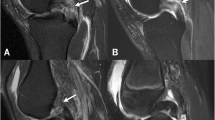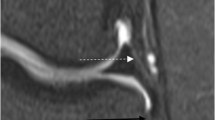Abstract
In the present study we investigated the validity of magnetic resonance imaging (MRI) and arthroscopy in knees with acute, traumatic extension deficit (the “locked knee”), and evaluated whether arthroscopy of knees with no mechanical pathology could be avoided by MRI evaluation. The study consisted of 50 patients who had an acute, traumatic extension deficit of the knee. All patients were submitted to MRI prior to arthroscopy. Following MRI and surgery, standardized forms were filled out, attempting to objectify the findings. The orthopaedic surgeon was not aware of the MRI result prior to surgery. Evaluating MRI, all grade-3 meniscal lesions were considered able to cause a mechanical block as well as acute partial or total anterior cruciate ligament (ACL)-ruptures. ACL-ruptures with an old appearance were not considered able to cause locking. Assuming that arthroscopy was the gold standard, the following results were calculated for the overall appearance of a lesion able to cause locking: Positive predictive value = 0.85, negative predictive value = 0.77, sensitivity = 0.95, specificity = 0.53. Two knees were erroneously evaluated with no mechanical locking at MRI (one bucket-handle lesion and one pathological synovial plica). MRI of the knee with acute, traumatic extension deficit is in the acute or subacute phase a safe method to identify the patients that have a mechanical reason for locking and therefore can benefit from arthroscopic treatment.

Similar content being viewed by others
References
Allum RL, Jones JR (1986) The locked knee. Injury 17:256–258
Lundberg M, Odensten M, Thuomas KA, Messner K (1996) The diagnostic validity of magnetic resonance imaging in acute knee injuries with hemarthrosis. A single-blinded evaluation in 69 patients using high-field MRI before arthroscopy. Int J Sports Med 17:218–222
Burnett R, Allum RL (1993) Relevance of history of injury to the diagnosis of meniscal tears. Ann R Coll Surg Engl 75:229–230
Shakespeare DT, Rigby HS (1983) The bucket-handle tear of the meniscus. A clinical and arthrographic study. J Bone Joint Surg Br 65:383–387
Bansal P, Deehan DJ, Gregory RJ (2002) Diagnosing the acutely locked knee. Injury 33:495–498
Chun CH, Lee BC, Yang JH (2002) Extension block secondary to partial anterior cruciate ligament tear on the femoral attachment of the posterolateral bundle. Arthroscopy 18:227–231
Elliott JM, Tirman PF, Grainger AJ, Brown DH, Campbell RS, Genant HK (2000) MR appearances of the locked knee. Br J Radiol 73:1120–1126
Stamatoukou A, Haslam P, Wilton T, Geutjens G (2002) Locked knee caused by a loose body in the fabellofemoral joint. Am J Sports Med 30:128–129
Elsworth C (1983) Locked knee and osteochondritis dissecans. J R Soc Med 76:1030–1031
Fischer SP, Fox JM, Del PW, Friedman MJ, Snyder SJ, Ferkel RD (1991) Accuracy of diagnoses from magnetic resonance imaging of the knee. A multi-center analysis of one thousand and fourteen patients. J Bone Joint Surg Am 73:2–10
Cusmano F, Uccelli M, Pedrazzini M, et al (2000) Meniscal injuries of the knee. Diagnostic imaging. Acta Biomed Ateneo Parmense 71:265–272
Munk B, Madsen F, Lundorf E, et al (1998) Clinical magnetic resonance imaging and arthroscopic findings in knees: a comparative prospective study of meniscus anterior cruciate ligament and cartilage lesions. Arthroscopy 14:171–175
Boden SD, Davis DO, Dina TS, et al (1992) A prospective and blinded investigation of magnetic resonance imaging of the knee. Abnormal findings in asymptomatic subjects. Clin Orthop Relat Res 282:177–185
Alioto RJ, Browne JE, Barnthouse CD, Scott AR (1999) The influence of MRI on treatment decisions regarding knee injuries. Am J Knee Surg 12:91–97
McNally EG, Nasser KN, Dawson S, Goh LA (2002) Role of magnetic resonance imaging in the clinical management of the acutely locked knee. Skeletal Radiol 31:570–573
Niitsu M, Endo H, Ikeda K, Itai Y (2000) MR imaging of the flexed knee: comparison to the extended knee in delineation of meniscal lesions. Eur Radiol 10:1824–1827
Imhoff A, Buess E, Hodler J, Fellmann J (1997) Comparison between magnetic resonance imaging and arthroscopy for the diagnosis of knee meniscal lesions. Rev Chir Orthop Reparatrice Appar Mot 83:229–236
De Smet AA, Graf BK (1994) Meniscal tears missed on MR imaging: relationship to meniscal tear patterns and anterior cruciate ligament tears. Am J Roentgenol 162:905–911
Rubin DA, Kettering JM, Towers JD, Britton CA (1998) MR imaging of knees having isolated and combined ligament injuries. Am J Roentgenol 170:1207–1213
Javed A, Siddique M, Vaghela M, Hui AC (2002) Interobserver variations in intra-articular evaluation during arthroscopy of the knee. J Bone Joint Surg Br 84:48–49
Westphal V, Krogsgaard MR (2001) Diagnostic knee arthroscopy under local anesthesia in hospital. An assessment of the diagnostic reliability, course of the treatment and health care costs. Ugeskr Laeger 164:60–64
Perin B, Nardacchione R, Bonaga S, et al (1997) Acute knee block. Assessment with magnetic resonance, correlated with arthroscopy. Radiol Med (Torino) 93:40–44
Acknowledgment
This research study was supported by a grant from Bispebjerg Hospital’s Research Foundation.
Author information
Authors and Affiliations
Corresponding author
Rights and permissions
About this article
Cite this article
Helmark, I.C., Neergaard, K. & Krogsgaard, M.R. Traumatic knee extension deficit (the locked knee): can MRI reduce the need for arthroscopy?. Knee Surg Sports Traumatol Arthr 15, 863–868 (2007). https://doi.org/10.1007/s00167-006-0244-1
Received:
Accepted:
Published:
Issue Date:
DOI: https://doi.org/10.1007/s00167-006-0244-1




